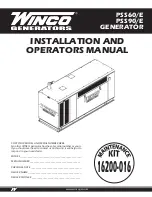
15
OPM-117/B
VOLTAGE REGULATOR
WIRING
AS440 Automatic Voltage Regulator
The following is a list of connections on the AVR. These
have been factory set and other than voltage adjustment,
should never be changed.
1. VOLTS - Adjust generator output voltage.
Clockwise to increase voltage.
2. LINK: HAND TRIMMER
1-2: NO TRIMMER
NONE: TRIMMER FITTED
Adjust alternator output voltage
Clockwise to increase voltage by AVR voltage adjustment.
3. STABILITY - To prevent voltage hunting.
Clockwise to increase dampening effect.
4. LINK: POWER: RESPONSE
A-B: > 550kW : Fast
B-C: 100-550kW : Fast
A-C: < 100kW : Fast
B-D: < 100kW : Slow
5. UFRO - Under Frequency Roll Off
Clockwise decreases ‘KNEE’ point.
6. SWITCH - Select alternator frequency for UFRO
SWITCH LEFT: 60Hz
SWITCH RIGHT: 50Hz
7. LED Indicator Light - LED light on in UFRO or O/EXC
condition.
8. DROOP - Adjust alternator droop to 5% at zero power
factor.
Clockwise to increase increase droop.
9. TRIM - Adjust analog input sensitivity.
Clockwise to increase sensitivity.
10. O/EXC - Adjust over-excitation trip.
Clockwise to increase trip voltage.
11. LINK: SUPPLY
8-Z2: Main stator
None: Auxiliary winding
Select AVR supply source.
1
9
10
11
2
7
6
4
3
8
5
PREVENTATIVE
MAINTENANCE
Reasonable care in preventative maintenance will ensure
high reliability and a long life for the engine-generator set
and Automatic Transfer Switch.
WARNING:
When performing any type of maintenance on this
equipment, make sure the selector switch on the engine-
generator is in the off position. If you are working in the
Automatic Transfer Switch, confirm with a reliable meter
that all power has been disconnected.
AUTOMATIC TRANSFER SWITCH
Clean and inspect the switch once a year. De-energize
all power sources, both line and engine-generator set,
then brush and vacuum away any excessive dust or
dirt accumulation. At this time, with the conductor de-
energized, you can remove the contact covers and check
the contacts. Make sure contacts are clean and not burned
or pitted.
ENGINE-GENERATOR SET
Service the engine in accordance with the engine
manufacturer’s manual provided with your new equipment.
Routinely remove debris and dirt from around the inside
generator enclosure. Ensure that the air intakes are free
from leaves and other debris at all times.
Clean and inspect battery terminals at least twice a year.
Also check the battery water level at least twice a year.
Other than keeping the generator clean and free of debris,
there is no other routine or preventative maintenance
required as long as the generator is run bi-weekly to keep it
dry and in good working order.
COLD WEATHER OPERATION
Extreme cold weather operation requires special
considerations. Higher CCA batteries are required for cold
weather starting; 650 CCA or larger are recommended. In
addition, you should consider installing an oil heater kit and
a battery warmer for reliable starting during cold weather.






































